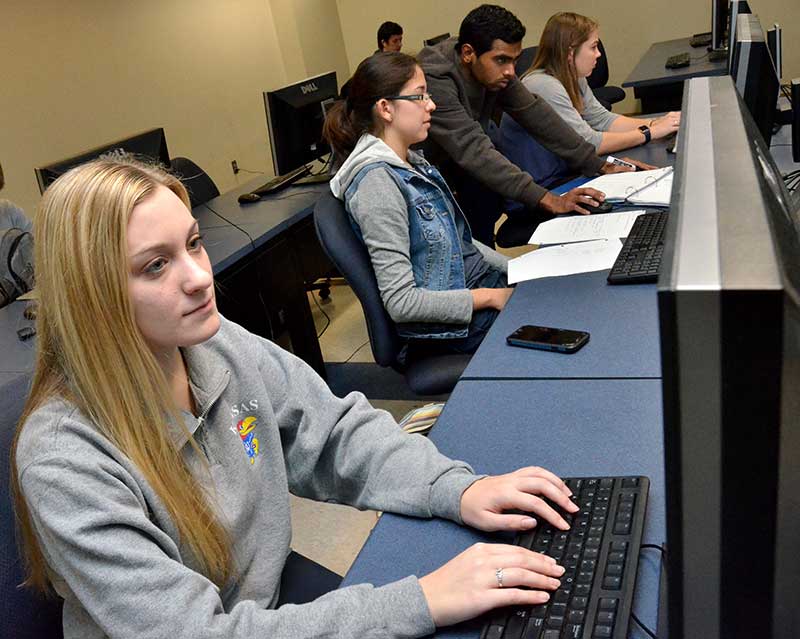Computing the possibilities

LAWRENCE — Sandy Rech was recently participating in a biology lab when it became clear she had a big advantage over her fellow students: She knew how to use the computer software that tracked the results of class experiments — and her classmates did not.
For Rech, it was a vision of her future.
“A lot of the students were staring at the computer, really confused, not sure what to do,” said Rech, a sophomore from Wichita. “And I was like, ‘I’ve seen that before.’ I was able to press the buttons and be well on my way.”
The reason for Rech’s advantage? She’s majoring in interdisciplinary computing, a program offered at KU and only a few other universities in the United States.
“The basic idea behind this degree is to pair computer science with another discipline where that computer science expertise would be applied,” said Dave Petr, professor of electrical engineering & computer science.
Here’s how it works: Interdisciplinary computing majors pick a field of concentration — astronomy, biology, chemistry, geography, journalism or physics — and marry their scientific studies to classes in computer science. Instead of being a double major, the program integrates classes from both disciplines.
“The ideal job for one of these students would be on a team — let’s just use biology as an example — on a computational biology team and they are the computational expert,” Petr said. “You can’t just take a plain vanilla computer scientist and throw them into a situation like that, because they don’t even know how the biologists talk. And you can’t write good programs if you don’t understand the problems that the scientists are dealing with. So the idea is to give the students enough of a foundation in the concentration area to at least speak the language.”
KU’s program started in 2011. There are currently about 20 students; there have been 10 graduates in the major so far.
Gregory Rudnick, associate professor of astronomy, said the growing computerization of scientific and professional fields requires increasing numbers of workers fluent in software and in scientific analysis.
“Most scientists are trained in science first, computations later, but science is really dependent on doing the computations fast and well,” Rudnick said. “Having somebody who is trained as a computer scientist first, but who also has with an appreciation for the scientific problems and knows how to solve them, could be highly marketable.”
One example from astronomy: A new large research telescope coming online in 2020 will generate 1.5 TB of data during each evening’s observations and will identify 10 million objects each night that vary in their brightness. Some of these will be completely new to science, but there are far too many for scientists to sift through by hand to find these unique needles in the haystack.
“You’re going to need machine learning to identify these new objects,” Rudnick said. “People who have experiences in this area have a clear advantage.”
Despite that demand, though, programs like the one at KU are still relatively rare. One exception: The “CS+X” program introduced in 2014 at Stanford University.
“I don’t believe there’s another Big 12 school that has anything like this,” Petr said. “There certainly wasn’t at the start. And I don’t know that there are any others in the Midwest.”
If the program helps budding scientists to obtain the computer skills they’ll need for their profession, officials say it’s also true the program can appeal to computer science-oriented students who want to broaden their education.
“The bottom line is, people don’t want to just write code to be writing code,” said Arvin Agah, associate dean of engineering research and graduate programs and professor of electrical engineering & computer science. “They want to write code that can have a direct impact in addressing challenges we face in the real world.”
Indeed, Petr said, the program has sent grads on to work and pursue graduate studies in their fields of concentration — but has also become a proven training ground for computer science students who go on to careers in, well, computer science.
“We do know that some of the students have just gone into traditional computer science jobs, and that’s another feature of the degree,” Petr said. “Even though the ideal situation is you’re working in one in the concentration areas, doing something with that and with your computing expertise, we firmly believe this prepares students for any kind of computer science position.”
Rech, meanwhile, says that juggling computer and biology classes can be demanding. But she eventually hopes to be a marine biologist — and moments like the one in her biology lab have convinced her she’s on the right path in the interdisciplinary computing program.
“It lets me know,” she said, “that I’m doing what I want to do.”